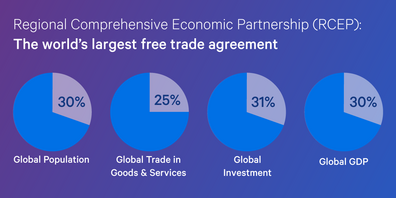
Navigating trade compliance obstacles in the Asia Pacific
Learn about the impact of the Regional Comprehensive Economic Partnership (RCEP) on APAC’s trade compliance dynamics and how to navigate the challenge.

Learn about the impact of the Regional Comprehensive Economic Partnership (RCEP) on APAC’s trade compliance dynamics and how to navigate the challenge.
The Asia Pacific region is evolving. Many free trade agreements have been concluded as the financial system grew more interconnected. These agreements allow for the free movement of goods between participating nations. But the solid foundations that have drastically enhanced the economy and living standards throughout the region can no longer be depended on to resolve the inevitable complexity increase and resulting disruptions.
With eight nations accounting for 30% of global GDP, the RCEP is the world's largest free trade agreement (FTA), simplifying commerce between Southeast Asian and Asia-Pacific nations. RCEP promises to deliver new business and employment opportunities, strengthen supply chains in the region, and promote the participation of micro, small, and medium enterprises in regional value chains and production hubs through new market access commitments and streamlined, modern rules and regulations that facilitate trade and investment.

While the US-China trade war and the COVID-19 epidemic continue to burden global companies' supply chains, the RCEP, through strengthening trade links, is projected to offer the much-needed push for businesses to recover from the current economic situation. The RCEP will undoubtedly establish new trade opportunities among Asian nations and expedite the region's economic recovery. The agreement would abolish tariffs on more than 90% of products over the next 10 to 15 years and adopt investment and intellectual property laws to support free trade. But even though the RCEP has several advantages, it also comes with certain drawbacks:
Trade patterns among the bloc's members will be altered, with most countries increasing both imports and exports. Trading organizations in the logistics and commerce sectors may thus face additional demand that they need to manage with their current infrastructures, resulting in bottlenecks and delays. Companies may get overwhelmed and unable to fully realize the benefits of RCEP if trade procedures are not promptly automated and digitized. Trade compliance has also come under scrutiny as huge corporations struggle to cope with increased risks to their bottom line and brand posed by swiftly shifting and more complex regulations across multiple jurisdictions. Negligence to recognize the importance of compliance knowledge and skills puts businesses at risk of regulatory violations, fines, and reputational damage which in turn can lead to shortages and supply chain disruptions.
While the signing of RCEP is undoubtedly a significant step in the Asia-Pacific economic environment, it is not the only FTA that has recently been inked. In reality, Asia-Pacific nations have been busy signing a slew of additional free trade agreements with significant trading partners from across the world. In the context of global trade conflicts and heightened trade risks, having so many FTAs in Asia-Pacific to profit from is excellent news for most Asian-based enterprises. They deliver much-needed supply chain cost reduction possibilities and transparency in trade lanes. However, juggling so many different FTAs creates significant operational hurdles for organizations in securing favorable outcomes while also maintaining regulatory compliance in their FTA operations.
For instance, when validating tariff shifts under the change in tariff classification rule or reviewing the relevant rules of origin for a specific FTA, it is important to translate the HS codes used today to the HS codes used when the provided FTA was signed. If HS codes are not transformed, incorrect rules may be applied, or errors in the tariff shift confirmation procedure may occur. Comprehending the conditions that determine whether items qualify for favorable tariff rates per FTA is a major difficulty for many businesses. FTAs are not "free" in this sense; rather, they are conditional agreements that require significant effort to comprehend all associated rules, build solid procedures and systems and reap the benefits.
The challenge for businesses lies in reinforcing their existing FTA operating models to maximize duty saving prospects throughout their supply chain while also operating in a way that ensures compliance and readiness for possible future inspections from authorities. Given the number of FTAs accessible in Asia-Pacific and the number of products and materials that companies would want to use them in their supply chain, it is almost impossible for enterprises to effectively and efficiently manage FTA-related activities with limited internal resources and manual procedures.
The full impact of the expected increase in commerce resulting from the introduction of RCEP will take some time to unfold. Nonetheless, it has already begun, and trade enterprises across the region must prepare for the additional demand and pressure on current logistics networks that the effect of this agreement will entail. Acquiring the correct mix of technology and qualified individuals is a precondition for businesses to stay ahead of the competition through increasing efficiency in FTA utilization and improved FTA compliance.
Fortunately, technological advancements continue to offer new opportunities for businesses to modernize their trade operation. Having the right technology to automatically pull relevant trade data to automate business partner screening, export controls processes, self-learning classification, transactional activities like HS coding and origin reviews, will be critical to a successful business transformation and adaptation to the new trade landscape.
AEB's Trade Compliance Management software solutions make it possible to automate and seamlessly document all export control steps, greatly minimizing the risk of criminal violations of foreign trade laws and regulations. Including screening your business partners, running export control checks across jurisdictions, managing licences, and keeping tabs on risks across your organization.
With constantly available and up-to-date cloud software for Compliance Screening, License Management, Export Controls, Product Classification, and Risk Assessment, AEB's Trade Compliance Management solutions provide full protection for your company's export control operations. The solutions automatically interface with your ERP or CRM platforms, such as SAP®, Salesforce, or Microsoft Dynamics 365. With its Customs and Logistics portfolio, AEB additionally delivers increased transparency, efficiency, cost savings, and legal protection to supply chain management by automating customs declarations, embargo checks, shipping, and invoicing operations, and IT integration of supply chain partners.